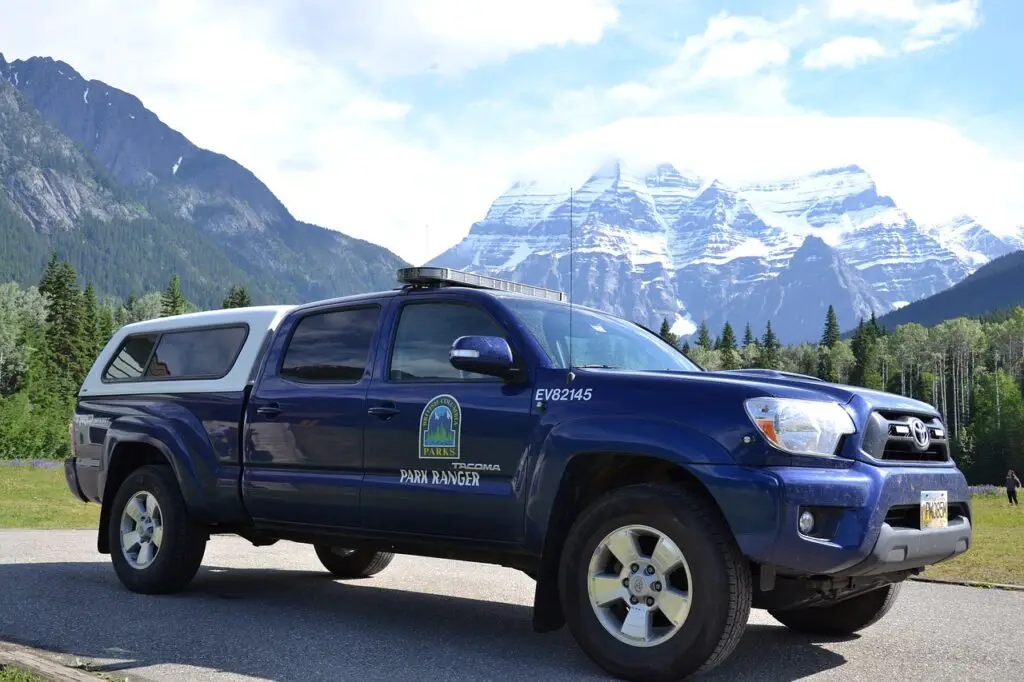Feral people in national parks choose to live undetected in the wilderness, outside of park rules and regulations. Some view these individuals as adventurous, while others view them as threatening visitor safety and the natural environment.
To avoid detection, feral people often create stealth camps in forested valleys, hidden canyons, or discrete hollows. This phenomenon is a growing concern for park rangers and visitors alike. It not only poses a threat to visitor safety but also endangers the natural ecosystem of the parks. Sometimes considered homeless, these people often avoid detection from park authorities by living far away from popular trails and roads.
Explore the issue of feral people in national parks and discuss its causes, effects, and potential solutions.

Who are Feral People in National Parks?
Feral people in national parks are those who have chosen to live off the grid, outside of the rules and regulations established for park visitors. They may be considered homeless, but they differ from other homeless populations in that they actively seek to live in the wilderness, far away from established trails and roads.
Characteristics of Feral People
Feral people are often characterized by their self-sufficiency, using the resources of the park to meet their basic needs for food, shelter, and water.
They may build makeshift dwellings or shelters, hunt or forage for food, and rely on natural water sources.
Why Feral People Choose National Parks
There are a variety of reasons why people choose to live as feral people in national parks. Some may have a deep-seated desire to live off the land, rejecting modern society and its comforts.
Others may be fleeing from personal or societal problems, seeking refuge in the wilderness. Still others may be struggling with poverty, mental illness, or addiction, and find themselves unable or unwilling to live within the constraints of mainstream society.
Data on Feral People in National Parks
While there is no official data on the number of feral people living in national parks, it is estimated that there are thousands of individuals who choose this lifestyle. These individuals come from a wide range of backgrounds and demographics, but many are young and male.
The appeal of living off the land in a pristine wilderness environment may be particularly strong for those who feel disconnected from modern society and its values.
Challenges
Despite the allure of living as a feral person in a national park, there are significant challenges and risks associated with this lifestyle. The isolation and lack of resources in wilderness areas can be dangerous for those who are not adequately prepared, and the risks of injury, illness, or death are high.
In addition, feral people may face criminal charges if they violate park regulations, and their presence in the park can create conflicts with other visitors or law enforcement officials.
Overall, the lifestyle of feral people in national parks raises complex questions about individual freedom, social responsibility, and environmental preservation. While some may view these individuals as adventurers or rebels, others see them as a threat to the safety and preservation of the parks. As we continue to grapple with these issues, it is important to consider the diverse motivations and backgrounds of feral people, as well as the risks and challenges associated with this lifestyle. By understanding these factors, we can work towards creating a more sustainable and equitable approach to managing national parks and other wilderness areas.
Impact of Feral People on National Parks
Feral people who live in national parks can have a significant impact on both the environment and social dynamics within the park. This impact can be divided into three main categories: environmental, social, and legal.
Environmental Impact
Feral people may damage natural habitats and ecosystems by cutting down trees, building fires or structures, and disrupting wildlife. They may also over-harvest natural resources, such as fish or game, which can affect the health of local animal populations.
Additionally, they may inadvertently introduce non-native species, which can cause harm to native species and disrupt the ecosystem.
Social Impact
The presence of feral people can create conflicts with other park visitors, who may feel unsafe or uncomfortable with their presence. Additionally, feral people themselves may face safety concerns, especially if they are not prepared for the dangers of living in the wilderness.
This can result in accidents or injuries that require emergency response from park authorities. Furthermore, negative perceptions of feral people from other park visitors can harm the park’s reputation and public perception.
Legal Impact
Feral people living in national parks may be in violation of park regulations, such as camping or hunting restrictions. They may also face criminal charges if they engage in illegal activities, such as drug use or theft.
This can create legal challenges for park authorities, who may have limited resources to monitor and address the presence of feral people in the park. Additionally, the costs associated with managing the impact of feral people can be significant, including increased patrols and law enforcement efforts.
In conclusion, feral people living in national parks can have a significant impact on the park and its visitors. It is important for park authorities to consider the various impacts that feral people may have on the park and its visitors and develop strategies for addressing these issues.
This may involve increased enforcement of park regulations, education and outreach efforts to promote responsible behavior, and policies that balance individual autonomy with the need to protect and preserve national parks for future generations.

Policies and Responses to Feral People in National Parks
The issue of feral people living in national parks presents complex challenges for park authorities. To address this issue, a range of policies and responses have been developed, including:
Enforcement of Park Regulations
Park authorities may increase their enforcement of park regulations, such as camping or hunting restrictions, to discourage feral people from living in the park. This may involve increased patrols and monitoring efforts to detect and deter illegal activities.
Education and Outreach
Park authorities may also develop education and outreach efforts to promote responsible behavior among park visitors.
This may involve educating visitors on the impact of their actions on the park’s ecosystem and wildlife, and encouraging them to report any suspicious or illegal activity they observe.
Alternative Housing Options
Some park authorities may explore alternative housing options for feral people, such as designated camping areas or temporary housing units. This can provide a safer and more regulated environment for feral people to live in, while also reducing their impact on the park’s ecosystem.
Collaboration with Other Agencies
Park authorities may collaborate with other agencies, such as law enforcement or social services. Collaboration helps to address the issue of feral people living in national parks.
This can help to address issues such as chronic homelessness or mental health issues that lead feral people to parks.
Research and Evaluation
Finally, park authorities may conduct research and evaluations to understand the impact of feral people on the park. This can help to identify effective strategies for addressing this issue and inform future policy and management decisions.
The issue of feral people living in national parks requires a multifaceted response. This involves a range of policies and strategies. Developing a comprehensive and coordinated approach is key to addressing this issue.
Park authorities can promote responsible behavior among visitors, protect the park’s ecosystem and wildlife, and ensure visitor safety.

Ethical Considerations of Feral People in National Parks
The issue of feral people living in national parks raises a number of ethical considerations that park authorities must take into account.
Right to Access and Use Public Lands
One of the fundamental ethical considerations in this issue is the right of all individuals to access and use public lands. Feral people may argue that they have a right to live in the park and access its resources, regardless of park regulations.
Park authorities must balance this right with the need to protect the park’s ecosystem and ensure the safety of all park visitors.
Responsibility for Environmental Stewardship
Another ethical consideration is the responsibility of all individuals to act as environmental stewards and protect the natural resources of the park.
Feral people living in the park may be damaging the ecosystem and putting wildlife at risk, which goes against this responsibility.
Duty of Care for Vulnerable Populations
Feral people living in national parks may also be vulnerable populations, such as individuals experiencing homelessness or mental health issues.
Park authorities have a duty of care to ensure the safety and well-being of all park visitors, including vulnerable populations.
Avoiding Stereotyping and Discrimination Park
authorities must also be mindful of avoiding stereotyping and discrimination towards feral people living in national parks.
It is important to approach this issue with compassion and empathy, while still upholding park regulations and protecting the park’s ecosystem.
Balancing Short-Term and Long-Term Solutions
Finally, park authorities must balance short-term and long-term solutions to address the issue of feral people living in national parks. While enforcement of park regulations may provide a short-term solution, it is important to address the underlying issues that may be driving feral people to live in the park, such as homelessness or mental health issues.
In conclusion, the issue of feral people living in national parks raises complex ethical considerations that must be taken into account when developing policies and responses. By balancing the rights of all individuals to access and use public lands with the need to protect the park’s ecosystem and ensure the safety of all park visitors, park authorities can promote responsible behavior, protect vulnerable populations, and uphold their duty of care toward the park and its visitors.
Future of Feral People in National Parks
Feral people pose a complex issue for parks, requiring consideration of various factors. Park authorities can address this through law enforcement, monitoring, and support for vulnerable populations.
Prioritizing environmental stewardship and visitors’ safety, while upholding individuals’ rights to access public lands, is crucial. Policies must be developed that account for unique circumstances and underlying issues. Balancing interests and fostering responsible behavior will ensure long-term sustainability of parks.
Moving forward, it is important for park authorities to continue to prioritize environmental stewardship and the safety of all park visitors, while also upholding the rights of all individuals to access and use public lands.
This may involve developing more nuanced policies that take into account the unique circumstances of feral people living in national parks, as well as addressing the underlying issues that may be driving individuals to live outside of the bounds of the law.
Ultimately, the future of feral people in national parks will depend on the ability of park authorities to balance these competing interests, while also fostering a culture of responsible behavior and environmental stewardship among all park visitors. With careful planning and thoughtful consideration, it is possible to ensure the long-term sustainability and accessibility of our national parks for generations to come.

